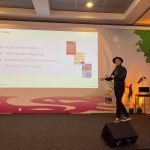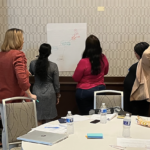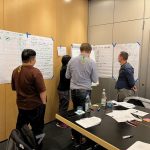More learnings from Agile Testing Days 2023! This is part 3, and I’ll need at least one more post! I still haven’t gotten to the extracurricular fun, though you can see in the featured image, ATD is conveniently located...
More learnings from Agile Testing Days 2023! This is part 3, and I’ll need at least one more post!
I still haven’t gotten to the extracurricular fun, though you can see in the featured image, ATD is conveniently located near the incredibly beautiful Sans Souci Park!
Dealing with conflict
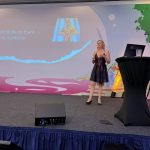 One of my favorite keynotes was prepared by Alex Schladebeck and Sophie Kuester: “A Fighting Chance: Learning the art of conflict resolution”. Sophie couldn’t be there for the talk, but Alex brought her stories and ideas to life. We heard many examples of people being “ducks” with each other, and how we can get roped into these dysfunctional situations.
One of my favorite keynotes was prepared by Alex Schladebeck and Sophie Kuester: “A Fighting Chance: Learning the art of conflict resolution”. Sophie couldn’t be there for the talk, but Alex brought her stories and ideas to life. We heard many examples of people being “ducks” with each other, and how we can get roped into these dysfunctional situations.
One of my big takeaways: Don’t tell someone who is upset to “calm down”, don’t tell them to not be angry or upset. That never works! We got lots of practical tips to deal with conflict. Listening and acknowledging others’ feelings goes a long way. Try to take a step back and observe what’s happening – be curious.
Name your own feelings. Of course they are valid, but control your own behavior. Respond, rather than reacting. Take a short break. Think of three reasons why that person who annoyed you did what they did that could be valid. Aim to understand the person, ask them to talk with you about it. Grace and vulnerability help promote better conversations.
Like anything, resolving conflict takes practice. Try something that’s safe to fail in your situation. Sometimes you just can’t improve a situation, though you can change yourself. Conflict can be an opportunity for change.
Faster feedback for 15 teams on a shared monolith
One of the things I value most about ATD is the diversity of speakers. It’s not all testing specialists, talking about testing. Thierry DePauw, an IT delivery consultant and engineer, shared how he helped an organization with 15 teams, 150 people, an one monolith, move from releasing twice a year, to releasing every two weeks. And this happened in the space of four months!
Thierry introduced improvement katas to help the teams work towards their targets. Once they understood the challenges, they could discuss small experiments to address them. They applied this approach to implementing value stream mapping. The value stream maps revealed bottlenecks, represented by colored sticky notes on the maps.
They experimented with ways to get a deployment pipeline running and deal with failing acceptance tests. My takeaway was the way they made bottlenecks, failure rates, and other problems visible to identify and overcome obstacles to more frequent releases. My experience is similar – the first step in overcoming a problem is to make it visible to everyone.
The golden ticket – ATD Virtual Pass!
Each time slot at ATD is packed with must-see sessions. Alas, we can each only pick one. However, this year we had a wonderful bonus – the Virtual Pass. All in person talks, plus a bunch more recorded virtual-only talks were on offer with the “conference-within-a-conference”. This is one reason I chose mostly workshops to attend in person – they can’t be recorded, since they’re mostly hands-on practice.
Sadly, it’s too late to buy a virtual pass and enjoy dozens and dozens of amazing talks. You can reach out to the various speakers to learn more about their topics, though.
The Test Automation Pyramid – still a classic
I’ve only watched a few of the recorded talks so far, but I have until February to keep learning from them! One session that caught my attention was Martijn Goossens‘ talk, “The Test Automation Pyramid for microservices”. Martijn refers to Martin Fowler’s 2012 blog post on the test automation pyramid, but of course, it goes back much farther. I worked for Mike Cohn in the early 00s when he first came up with the model. My team back then applied it with great success. Both Janet Gregory and I have helped teams over the years use the model to drive conversations that result in an effective test automation strategy.
At the same time, we’ve seen lots of people criticize the model or say it’s no longer relevant. I was glad to see that Martijn finds it still adds value, even in today’s complex world of microservices architecture. He explains the concepts of this thinking tool exceptionally well. His experience is similar to ours in that he finds the model helps drive useful discussions to decide the appropriate level for automating each set of tests. He also found it helps with shared responsibility across the team and organization. This is especially important when different teams are working on different services, and all those integrations have to be tested. Our systems get more complex and challenging, and, visual thinking tools like the test automation pyramid continue to guide us in managing risks.
To the Mun and beyond
I had the pleasure of reviewing Atilla “Raketenmann” Strba’s ATD proposal and watching a run-through of his talk, and giving feedback. He came up with one of my favorite talks of the conference. I learned a whole lot about testing embedded software through his hilarious tale of the Kerbals’ efforts to test embedded rocket software. 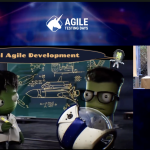 The Kerbals are adorable little aliens who have their own not-so-brilliant ideas about testing their rocket software, trying to reach the Mun – a fictitious version of the moon. Attila did a brilliant job contrasting the ways NOT to test embedded software – illustrated with animated cartoons of rocket disasters – with the approach he uses on real-life embedded software. “(Not) the Kerbal way” is definitely the better choice.
The Kerbals are adorable little aliens who have their own not-so-brilliant ideas about testing their rocket software, trying to reach the Mun – a fictitious version of the moon. Attila did a brilliant job contrasting the ways NOT to test embedded software – illustrated with animated cartoons of rocket disasters – with the approach he uses on real-life embedded software. “(Not) the Kerbal way” is definitely the better choice.
(Not) the Kerbal way of embedded testing starts with a scalable, easily and inexpensively built testbed. The test controller computer is important, for example, it should be a server with VMs, preferably Linux, with a remote controllable power supply. I found the architecture diagrams and pictures of the equipment fascinating. The not-Kerbal way also includes quality gates. For every code change, the pipeline has to pass unit tests, smoke tests, code review, integration tests, nightly tests, and after the release candidate is ready, semi-manual tests. Even after release, there’s a quality gate of long-term field tests.
The Kerbals didn’t have such a happy ending, but Raketenmann is rocking real-life embedded testing, and sharing good practices to reach for the Mun and beyond.
Micropowers: Learn to speak up and be heard
Eveline Moolenaars and Stephan Ka?mper introduced a concept that’s new to me – “micropowers”. They shared stories of situations where they saw a problem or had an idea, but were reluctant to speak up. They asked us to think about what micropowers we might have. Ask yourself – what am I good at? Trusting in that ability builds confidence. Then we can feel good about taking action, asking for help or sharing an idea, and being heard.
I had to think for awhile to come up with my own micropower. In 2023, I was invited to join a Code Reading Club with some awesome friends. I haven’t written code on my own in years, and felt rather lost as we looked at a piece of code. Then I realized I could see a pattern in the code that nobody else had noticed yet. I trusted my micropower to see patterns, and spoke up. It was an “aha” moment for the group to help understand the code. Recalling this incident makes me agree with Stephan and Eveline – trusting our micropower does give confidence to speak up, to take action!
A tale of a tester in Unicorn Land
Tamara Josten shared how she started her testing career as a charming fairy tale. The visuals in this talk were as  delightful and magical as the story. Tamara has so much courage to start a challenging new career, and to share the problems she faced and how she overcame them. Tamara overcame self-doubt and fear of failure to become fluent in English, learn to code in Python, and much more. She even faced the ISTQB wolf! She built relationships with many people who were happy to help – that makes me think of the micropowers talk! One of her micropowers might be her courage to face her fears and find a way to overcome them.
delightful and magical as the story. Tamara has so much courage to start a challenging new career, and to share the problems she faced and how she overcame them. Tamara overcame self-doubt and fear of failure to become fluent in English, learn to code in Python, and much more. She even faced the ISTQB wolf! She built relationships with many people who were happy to help – that makes me think of the micropowers talk! One of her micropowers might be her courage to face her fears and find a way to overcome them.
One of my big takeaways from this wonderful, inspiring tale is Tamara’s call to action to employers – hire a career changer! They bring valuable experience from their previous professions, and they’re obviously super motivated to succeed. I see a huge benefit for our software industry overall. Hiring career changers automatically brings in much more diversity to software organizations. We know that companies with more diversity in their employees make more money. It’s a win all the way around.
Agile Testing Days 2023 is a fairy tale for me, I have so many learnings to share! I’ll need at least one more post in this series. I have many more virtual sessions to watch. This has helped me avoid my usual post-ATD blues!
The post More learnings from Agile Testing Days 2023 – part 3 appeared first on Agile Testing with Lisa Crispin.



